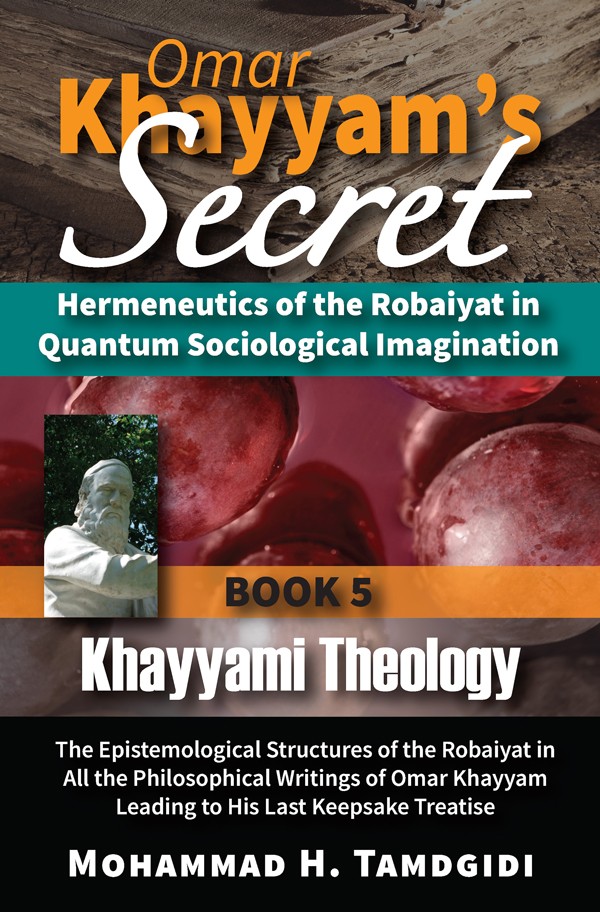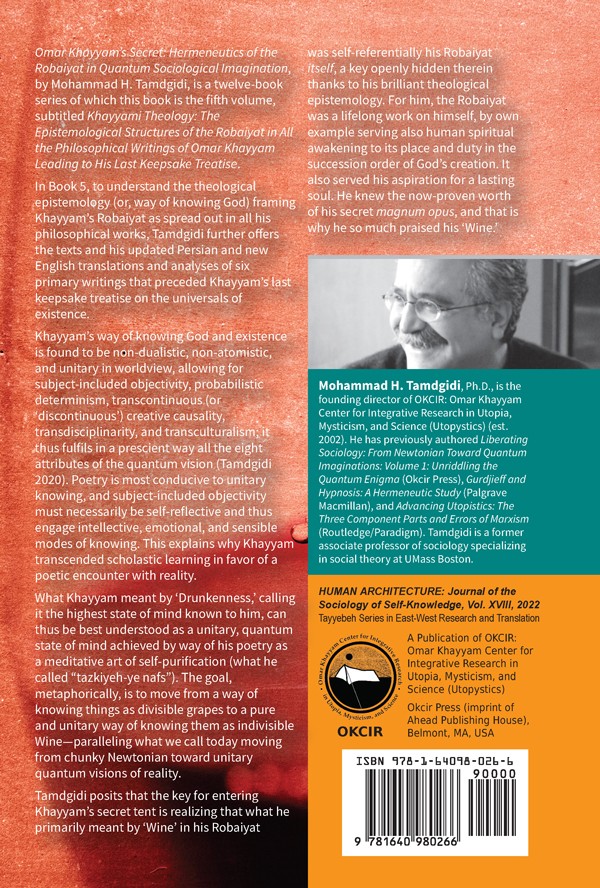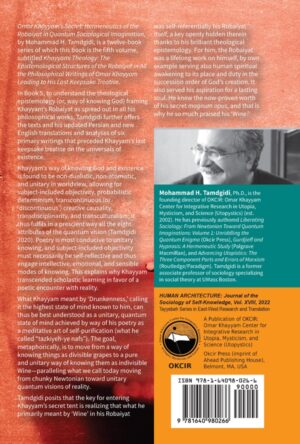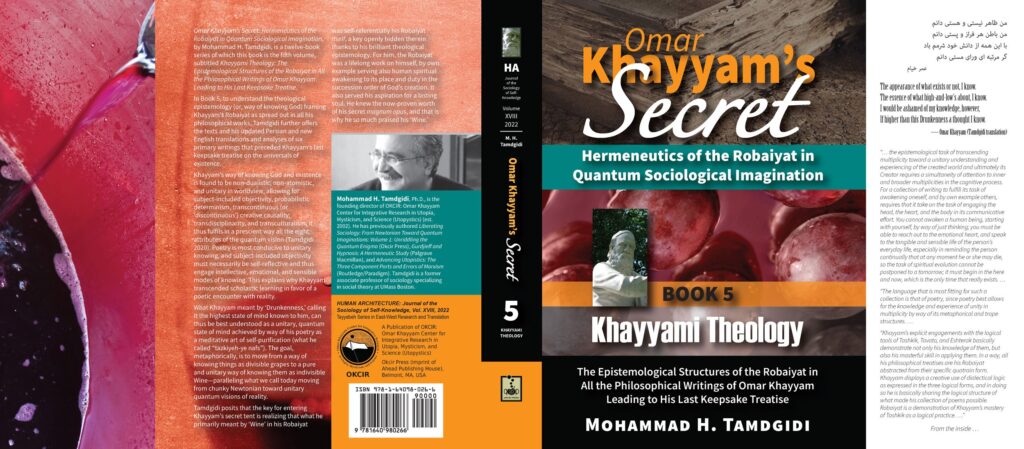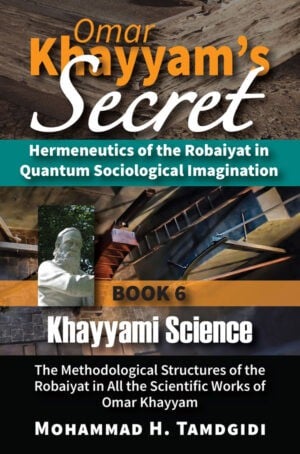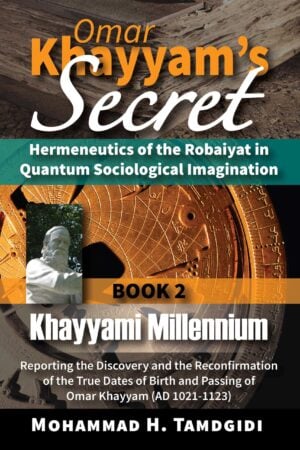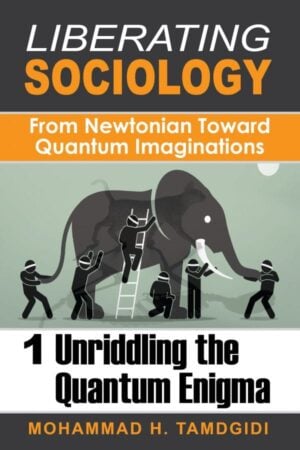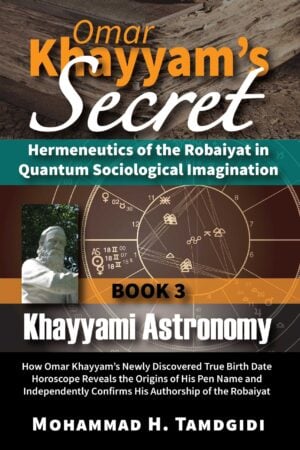Omar Khayyam’s Secret: Hermeneutics of the Robaiyat in Quantum Sociological Imagination: Book 5: Khayyami Theology: The Epistemological Structures of the Robaiyat in All the Philosophical Writings of Omar Khayyam Leading to His Last Keepsake Treatise
$69.99 – $109.00
In this 5th of his Omar Khayyam’s Secret 12-book series, M. H. Tamdgidi offers the Arabic texts and his update Persian and new English translations and analyses of all of Khayyam’s philosophical writings before his last treatise.
Publication Date: May 1, 2022
Note: The ePub ebook edition of this title (ISBN: 9781640980280) can be purchased from major online ebook stores worldwide.

All the sections of this publication can be read online by logged-in members of the OKCIR Library with a valid access. In that case click on any section in the table of contents below, and then click on the large PDF icon at the bottom of that page to access the publication section. Alternatively, you can purchase this publication as offered below.
Description
Omar Khayyam’s Secret: Hermeneutics of the Robaiyat in Quantum Sociological Imagination
Book 5: Khayyami Theology
The Epistemological Structures of the Robaiyat in All the Philosophical Writings of Omar Khayyam Leading to His Last Keepsake Treatise
Author: Mohammad H. Tamdgidi
Publication Date: May 1, 2022
Human Architecture: Journal of the Sociology of Self-Knowledge (ISSN: 1540-5699)
Volume XVIII, 2022, Monograph Series: Tayyebeh Series in East-West Research and Translation
Description
Omar Khayyam’s Secret: Hermeneutics of the Robaiyat in Quantum Sociological Imagination, by Mohammad H. Tamdgidi, is a twelve-book series of which this book is the fifth volume, subtitled Khayyami Theology: The Epistemological Structures of the Robaiyat in All the Philosophical Writings of Omar Khayyam Leading to His Last Keepsake Treatise. Each book, independently readable, can be best understood as a part of the whole series.
In Book 5, to understand the theological epistemology (or, way of knowing God) framing Khayyam’s Robaiyat as spread out in all his philosophical works, Tamdgidi further offers the texts and his updated Persian and new English translations and analyses of six writings that preceded Khayyam’s last keepsake treatise on the universals of existence.
The six primary texts include: 1: Khayyam’s annotated Persian translation of Avicenna’s sermon in Arabic on God and creation; 2: Khayyam’s treatise in Arabic addressed to Nasawi (who Tamdgidi shows has been wrongly regarded as an Avicenna pupil) on the created world and worship duty; 3-5: Khayyam’s three treatises in Arabic (which Tamdgidi shows were all addressed to Abu Taher, to whom Khayyam also dedicated his treatise on algebra) that are separate chapters of a three-part treatise on existence on topics ranging from the necessity of contradiction, determinism, survival, attributes of existents, and the light of intellect on ‘existent’ as the subject matter of universal science; and 6: Khayyam’s treatise in Arabic addressed to Moshkavi (who Tamdgidi reveals was a supportive Shia intellectual) in response to three questions on soul’s survival, on the necessity of accidents, and on the nature of time.
In this book it is shown that the most fruitful way of understanding Khayyam’s six texts is by regarding them as efforts made at defending his “succession order” thesis implicitly revealed when commenting on Avicenna’s sermon and finalized in his last keepsake treatise. The texts served to offer the theological epistemology behind Khayyam’s thesis, revealing his creative conceptualist view of existence that informed his poetic way of going about knowing God, creation, and himself within a unitary Islamic creationist-evolutionary worldview.
Khayyam’s way of knowing God and existence is non-dualistic, non-atomistic, and unitary in worldview, allowing for subject-included objectivity, probabilistic determinism, transcontinuous (or ‘discontinuous’) creative causality, transdisciplinarity, and transculturalism; it thus fulfils in a prescient way all the eight attributes of the quantum vision (Tamdgidi 2020). Poetry is most conducive to unitary knowing, and subject-included objectivity must necessarily be self-reflective and thus engage intellective, emotional, and sensible modes of knowing. This explains why Khayyam transcended scholastic learning in favor of a poetic encounter with reality. What he meant by ‘Drunkenness,’ calling it the highest state of mind known to him, can thus be best understood as a unitary, quantum state of mind achieved by way of his poetry as a meditative art of self-purification (what he called “tazkiyeh-ye nafs”). The goal, metaphorically, is to move from a way of knowing things as divisible grapes to a pure and unitary way of knowing them as indivisible Wine—paralleling what we call today moving from chunky Newtonian toward unitary quantum visions of reality.
Tamdgidi posits that the key for entering Khayyam’s secret tent is realizing that what he primarily meant by ‘Wine’ in his Robaiyat was self-referentially his Robaiyat itself, a key openly hidden therein thanks to his theological epistemology. For him, the Robaiyat was a lifelong work on himself, serving also human spiritual awakening to its place and duty in the succession order of God’s creation. It also served his aspiration for a lasting soul. He knew the now-proven worth of his secret magnum opus, and that is why he so much praised his ‘Wine.’
About the Author
Mohammad H. Tamdgidi, Ph.D., is the founding director and editor of OKCIR: Omar Khayyam Center for Integrative Research in Utopia, Mysticism, and Science (Utopystics) and its journal, Human Architecture: Journal of the Sociology of Self-Knowledge (ISSN: 1540-5699), which have served since 2002 to frame his independent research, pedagogical, and publishing initiatives. He is a former associate professor of sociology specializing in social theory at UMass Boston and has taught sociology at SUNY-Binghamton and SUNY-Oneonta.
Besides his currently in progress work published in the 12-book series Omar Khayyam’s Secret: Hermeneutics of the Robaiyat in Quantum Sociological Imagination (Okcir Press), Tamdgidi has previously authored Liberating Sociology: From Newtonian Toward Quantum Imaginations: Volume 1: Unriddling the Quantum Enigma (2020, Okcir Press), Gurdjieff and Hypnosis: A Hermeneutic Study (2009, Palgrave Macmillan), and Advancing Utopistics: The Three Component Parts and Errors of Marxism (2007, Routledge/Paradigm). He has published numerous peer reviewed articles and chapters and edited more than thirty journal issues.
Tamdgidi holds a Ph.D. and M.A. in sociology in conjunction with a graduate certificate in Middle Eastern studies from Binghamton University (SUNY). He received his B.A. in architecture from U.C. Berkeley, following enrollment as an undergraduate student of civil engineering in the Technical College of the University of Tehran, Iran.
His areas of scholarly and practical interest are the sociology of self-knowledge, human architecture, and utopystics-three fields of inquiry he invented in his doctoral studies and has since pursued as respectively intertwined theoretical, methodological and applied fields of inquiry altogether contributing to what he calls the quantum sociological imagination. His research, teaching, and publications have been framed by an interest in understanding how world-historical social structures and personal selves constitute one another. This line of inquiry has itself been a result of his longstanding interest in understanding the underlying causes of failures of the world’s utopian, mystical, and scientific movements in bringing about a just global society.
It was during his undergraduate studies at U.C. Berkeley and in the course of his mentorship by the painter and design architect Jesse Reichek (1916-2005) that Tamdgidi’s notion and project “human architecture” was born. During his graduate studies at SUNY-Binghamton, he was mentored in methods, theory, and world-systems studies by Terence K. Hopkins (1928-1997) and Immanuel Wallerstein (1930-2019), and further in dialectics by Dale Tomich and on space and society by Anthony D. King, amid a uniquely autonomous and flexible transdisciplinary Graduate Program in Sociology founded by T. K. Hopkins.
Omar Khayyam’s Secret: Hermeneutics of the Robaiyat in Quantum Sociological Imagination: Book 5: Khayyami Theology: The Epistemological Structures of the Robaiyat in All the Philosophical Writings of Omar Khayyam Leading to His Last Keepsake Treatise
Published by: Okcir Press (an imprint of Ahead Publishing House) • Belmont, Massachusetts • First Edition: May 1, 2022
590 pages • 6×9 inches • Includes references and index
Library of Congress Control Number (LCCN): 2022907262
ISBN: 9781640980266 (hard cover with dust jacket: alk. paper)
ISBN: 9781640980273 (soft cover: alk. paper)
ISBN: 9781640980280 (ePub ebook)
ISBN: 9781640980297 (PDF ebook)
CITATION: Tamdgidi, Mohammad H. 2022. Omar Khayyam’s Secret: Hermeneutics of the Robaiyat in Quantum Sociological Imagination: Book 5: Khayyami Theology: The Epistemological Structures of the Robaiyat in All the Philosophical Writings of Omar Khayyam Leading to His Last Keepsake Treatise. (Human Architecture: Journal of the Sociology of Self-Knowledge: Vol. XVIII, 2022. Tayyebeh Series in East-West Research and Translation.) Belmont, MA: Okcir Press.
Where to Purchase this Book: The various editions of this volume can be ordered from the Okcir Store and all major online bookstores worldwide (such as Amazon, Barnes&Noble, Google Play, and others).
Table of Contents
Omar Khayyam’s Secret: Hermeneutics of the Robaiyat in Quantum Sociological Imagination: Book 5: Khayyami Theology: The Epistemological Structures of the Robaiyat in All the Philosophical Writings of Omar Khayyam Leading to His Last Keepsake Treatise
Published to Date in the Series—ii
About the Author—viii
Acknowledgments—xix
Preface to Book 5: Recap from Prior Books of the Series—1
- Introduction—17
- The Persian Manuscript of Omar Khayyam’s Annotated Translation of Avicenna’s “Splendid Sermon” on God’s Unity and Creation—22
- New English Translation of the Manuscript of Omar Khayyam’s Annotated Persian Translation of Avicenna’s “Splendid Sermon” in Arabic on God’s Unity and Creation—28
- Comparative Textual Analysis of Omar Khayyam’s Annotated Persian Translation of Avicenna’s “Splendid Sermon” in Relation to the Sermon in Arabic—33
- Conclusion—78
- Introduction—85
- The Arabic Manuscript of Omar Khayyam’s “Treatise on the Created World and Worship Duty”—96
- Updated Persian Translation of Omar Khayyam’s “Treatise on the Created World and Worship Duty”—102
- New English Translation of Omar Khayyam’s “Treatise on the Created World and Worship Duty”—112
- Textual Analysis of Omar Khayyam’s “Treatise on the Created World and Worship Duty”—121
- Conclusion—170
- Introduction—175
- The Arabic Manuscript of Omar Khayyam’s Treatise on Existence, Part 1: On the Necessity of Contradiction, Determinism, and Survival—179
- Updated Persian Translation of Omar Khayyam’s Treatise on Existence, Part 1: On the Necessity of Contradiction, Determinism, and Survival—185
- New English Translation of Omar Khayyam’s Treatise on Existence, Part 1: On the Necessity of Contradiction, Determinism, and Survival—192
- Textual Analysis of Omar Khayyam’s Treatise on Existence, Part 1: On the Necessity of Contradiction, Determinism, and Survival—201
- Conclusion—233
- Introduction—237
- The Arabic Manuscript of Omar Khayyam’s Treatise on Existence, Part 2: On Attributes—242
- Updated Persian Translation of Omar Khayyam’s Treatise on Existence, Part 2: On Attributes—248
- New English Translation of Omar Khayyam’s Treatise on Existence, Part 2: On Attributes—258
- Textual Analysis of Omar Khayyam’s Treatise on Existence, Part 2: On Attributes—266
- Conclusion—299
- Introduction—305
- The Arabic Manuscript of Khayyam’s “Treatise on Existence, Part 3: On Existent: The Light of Intellect on the Subject Matter of Universal Science”—311
- Updated Persian Translation of Khayyam’s “Treatise on Existence, Part 3: On Existent: The Light of Intellect on the Subject Matter of Universal Science”—314
- New English Translation of Khayyam’s “Treatise on Existence, Part 3: On Existent: The Light of Intellect on the Subject Matter of Universal Science”—319
- Textual Analysis of Omar Khayyam’s “Treatise on Existence, Part 3: On Existent: The Light of Intellect on the Subject Matter of Universal Science”—323
- Conclusion—343
- Introduction—347
- The Arabic Manuscript of Omar Khayyam’s Treatise “Response to Three Questions: Soul’s Survival, Necessity of Accidents, and Nature of Time”—351
- Updated Persian Translation of Omar Khayyam’s Treatise “Response to Three Questions: Soul’s Survival, Necessity of Accidents, and Nature of Time”—356
- New English Translation of Omar Khayyam’s Treatise “Response to Three Questions: Soul’s Survival, Necessity of Accidents, and Nature of Time”—363
- Textual Analysis of Omar Khayyam’s Treatise “Response to Three Questions: Soul’s Survival, Necessity of Accidents, and Nature of Time”—370
- Conclusion—403
- Introduction—409
- Integrating the Structures of Khayyam’s Theological Epistemology and Ontology Framing His Robaiyat As Studied in the Series So Far—411
- ‘Drunkenness’ As a Quantum State of Mind: How Omar Khayyam’s Theological Epistemology Fulfills the Eight Attributes of the Quantum Vision—450
- What Khayyam Primarily Meant by ‘Wine’ in His Robaiyat Was His Robaiyat Itself—464
- Conclusion—478
Conclusion to Book 5: Summary of Findings—483
Appendix: Transliteration System and Book 5 Glossary—513
Book 5 Cumulative Glossary of Transliterations—526
Book 5 Index—541


